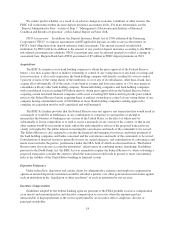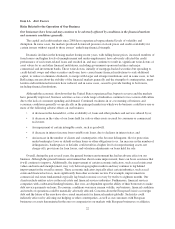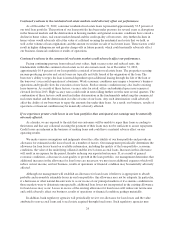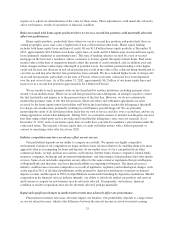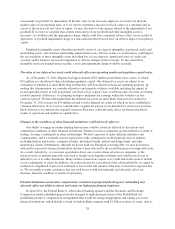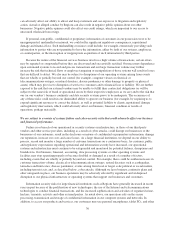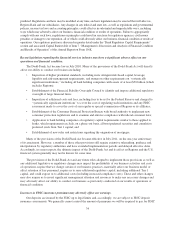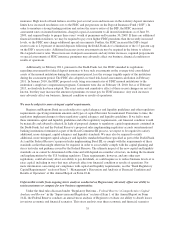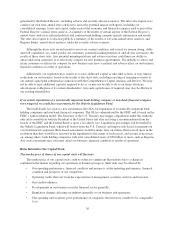Regions Bank 2012 Annual Report Download - page 43
Download and view the complete annual report
Please find page 43 of the 2012 Regions Bank annual report below. You can navigate through the pages in the report by either clicking on the pages listed below, or by using the keyword search tool below to find specific information within the annual report.issued to the U.S. Treasury. Additionally, in March 2012 Fitch conducted a global review of securities impacted
in part by capital requirements set forth in Basel III as well as Fitch’s view regarding the likelihood of sovereign
support. The review resulted in a downgrade of Regions’ junior subordinated debt rating from BB to B+. In
December 2012, Moody’s upgraded Regions’ senior debt ratings from Ba3 to Ba1, citing declining net charge-
offs and loan delinquencies, as well as enhancements to the risk management structure. Currently, Regions’
senior debt ratings are Ba1, BBB-, BBB- and BBB by Moody’s, S&P, Fitch and DBRS, respectively.
In general, ratings agencies base their ratings on many quantitative and qualitative factors, including capital
adequacy, liquidity, asset quality, business mix and level and quality of earnings, and we may not be able to
maintain our current credit ratings. The ratings assigned to Regions and Regions Bank remain subject to change
at any time, and it is possible that any ratings agency will take action to downgrade Regions, Regions Bank or
both in the future.
Additionally, ratings agencies may also make substantial changes to their ratings policies and practices
which may affect our credit ratings. In the future, changes to existing ratings guidelines and new ratings
guidelines may, among other things, adversely affect the ratings of our securities or other securities in which we
have an economic interest.
Regions’ credit ratings can have negative consequences that can impact our ability to access the debt and
capital markets, as well as reduce our profitability through increased costs on future debt issuances. Specifically,
when Regions was downgraded below investment grade status, we became unable to reliably access the short-
term unsecured funding markets, which caused us to hold more cash and liquid investments to meet our on-going
cash needs. Such actions reduced our profitability as these liquid investments earned a lower return than other
assets, such as loans. Regions’ liquidity policy requires that we maintain a minimum cash requirement that is the
greater of the next two years of corporate dividend payments and debt service and maturities less the next one
year of bank dividends, or the next one year of corporate dividend payments and debt service and maturities. The
current working limit does not allow the minimum cash requirement to fall below $500 million. The conservative
nature of this policy helps protect us against the costs of unexpected adverse funding environments. Future
issuances of debt could cost Regions more in interest costs were such debt to be issued at our current debt rating.
Any future downgrades would further increase the interest costs associated with potential future borrowings, the
cost of which cannot be estimated due to the uncertainty of future issuances in terms of amount and priority.
Additionally, at the time Regions was downgraded to below investment grade, certain counterparty contracts
were required to be renegotiated, resulting in additional collateral postings of approximately $200 million. Refer
to Note 20, “Derivative Financial Instruments and Hedging Activities, Contingent Features” to the consolidated
financial statements of this Annual Report on Form 10-K for the fair value of contracts subject to contingent
credit features and the collateral postings associated with such contracts. Future downgrades could require
Regions to post additional collateral. While the exact amount of additional collateral is unknown, it is reasonable
to conclude that Regions may be required to post approximately an additional $200 million related to existing
contracts with contingent credit features. In early 2013, as a result of the ratings upgrades that occurred during
2012, approximately $70 million of this additional collateral has been returned to Regions. If due to future
downgrades, we were required to cancel our derivatives contracts with certain counterparties and were unable to
replace such contracts, our market risk profile could be altered. Regions believes that this market risk exposure
would be immaterial to its consolidated financial position, liquidity and results of operations.
The value of our goodwill and other intangible assets may decline in the future.
As of December 31, 2012, we had $4.8 billion of goodwill and $345 million of other intangible assets. A
significant decline in our expected future cash flows, a significant adverse change in the business climate, slower
growth rates or a significant and sustained decline in the price of our common stock, any or all of which could be
materially impacted by many of the risk factors discussed herein, may necessitate our taking charges in the future
related to the impairment of our goodwill. Future regulatory actions could also have a material impact on
27



